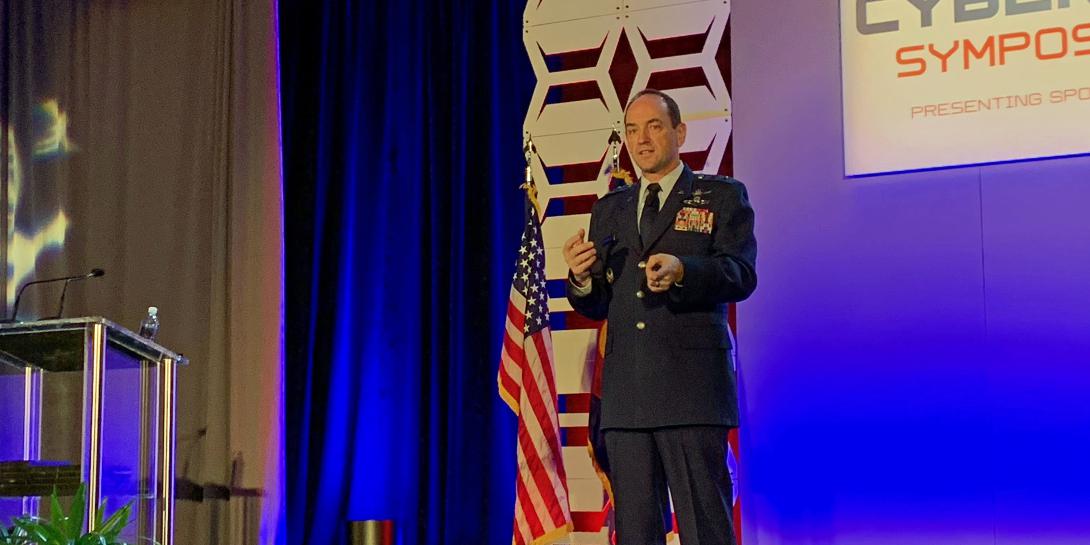Enterprise Platform To Bridge the Technology Gap for the Air Force
Modernizing information technology across 700,000 U.S. Air Force personnel is not a simple venture. Updating legacy systems, moving applications and data to the cloud, enabling the use of mobile devices, securing appropriate licensing and supplying powerful computing are complex undertakings. The pursuit of a digital transformation is a vital effort of the service, said Maj. Gen. Kevin Kennedy, USAF, assistant deputy chief information officer, Digital Transformation, and assistant deputy chief of staff for Cyber Effects Operations.
Gen. Kennedy spoke at the AFCEA Rocky Mountain Cyberspace Symposium in Colorado Springs, Colorado, on February 5. The general mentioned that when he refers to the Air Force these days, it also includes the U.S. Space Force. “We are coupled together,” he noted. “And we don’t expect to see any daylight in our formations as we move forward on this.”
At stake in the digital metamorphosis, beyond the critical importance of having a protected and resilient network and information technology that supports airmen and operations in an increasingly adversarial climate, is the existence of the service itself, Gen. Kennedy said. It is a lesson he learned from the chief of the Air Force when Gen. Kennedy briefed a previous Wing Commander Conference.
We are partnering closely with DOD and the Joint Staff to field key Joint All Domain Command and Control (JADC2) tech, says Air Force’s Assistant Deputy CIO, Digital Transformation &Assistant Deputy Chief of Staff for Cyber Effects Operations, MG Kevin Kennedy #RMCS20 @AFCEARMC pic.twitter.com/U49AJXzYJm
— Kimberly Underwood (@Kunderwood_SGNL) February 5, 2020
“It is a retention issue,” he stated. “The perception is that we're a world-class air force, which is true, with the greatest air and space force ever fielded, and it's not even close, but that perception is cut away when you join this world-class force and you have the sense that your technology, your information technologies, aren’t supporting you in a way that you know is possible as an airman. And that's what we're going to break through here.”
Underpinning the digital transformation is the service’s adoption of Enterprise Information Technology as a Service, known as EITaaS. The service is currently progressing through a risk-reduction effort for EITaaS at eight Air Force bases. The goal of the EITaaS model is to have industry-standard capabilities, Gen. Kennedy stated. “It is not good enough until it's commercial-level quality. That is what we're trying to aim for. This is a paradigm shift.”
The EITaaS platform will support the network, use of devices, cloud storage, edge computing and digital tools. For the network piece, EITaaS will enable both wired and Wi-Fi networks, and 4G and 5G capabilities, at higher data rates. It will enable more robust data gathering and sensing through the expanded use of devices by relying on the latest mobile technology, high-end personal computers and on-base genius bars, the general noted. For the cloud, EITaaS will make sure airmen receive accelerated migration of applications to the cloud, specialized cloud support and a comprehensive development security operations platform.
“We are pushing information to the cloud so it is exposable, shareable, discoverable, so we can enable our artificial intelligence, machine learning, autonomy journey,” the general said. “If we don't put it in a place that's exposable, it's stale. If you don't have the most recent data that you are doing better than before with your algorithms and assessments of where you want to go based on information … you're still not as good as you could be.”
In addition, EITaaS will bring compute power to airmen at the tactical edge, providing base-level data and resilience, Gen. Kennedy indicated. “What do we have for resilience at the edge?” the general asked. “In an age of constant competition and persistent engagement in cyberspace, the fundamental assumption underneath that is, rather than being purely offensive in nature, some level of resilience. I didn't say hardening, but some level of resilience that you can accomplish your mission in different paths. And if we don't do that in the enterprise, we fall into an offensive-defensive struggle.”
Key to the EITaaS task is scaling it across the service and those 700,000 users and addressing licensing through the Joint Enterprise Licensing Agreement environment, or JELA.
While subscribing to enterprise infrastructure allows the Air Force to bypass the investment to own hardware and software, the EITaaS effort has to be affordable, Gen. Kennedy stressed.
“We're learning how we're going to do this in a way, in a partnership, that maintains affordability and capability,” the general stated. “So, we have to learn those lessons. The EITaaS risk-reduction exercise is as much an acquisition learning experience as it is a technology learning experience. That is really what it is—how do we design in our partnership as we continue down this road together.”
The service is working closely with the Army as they also implement EITaaS—although the Army is looking at more of an integration by post, while the Air Force is adding functionality across the bases, the general noted.





Comment
EITaaS information on RFI
EITaaS information on RFI release dates!
Comments